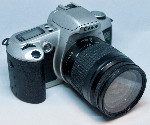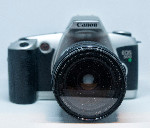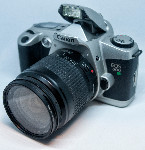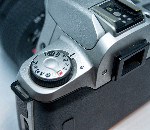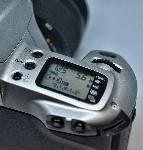Time to look at a grown-up camera, the Canon EOS500N and some rather experimental films.
The swansong of film cameras
Canon EOS500N
Camera: £0.99
Canon AF28-80
Lens: £14.70
Postage: £6.85
Total: £22.54
The Full PictUre
The camera is a full-frame 35mm SLR camera with autofocus and electronic control lens aperture. Actually, saying it is “full frame” is kind of redundant as all 35mm cameras were full-frame, otherwise you wouldn’t get a full picture in the frame of the film. The reason it becomes significant is when selecting a lens – you have to make sure it is a full-frame lens. Modern mid-range digital SLR cameras have a sensor which is quite a bit smaller than a 35mm film was, it’s around the same size as APS film was, so it’s called an APS-C sensor – it’s about 2/3rds of the size. The reason this matters is that even though the cheaper-to-source and very-widely-available lenses made for those digital camera are fully compatible they don’t produce an image large enough to cover the whole of the film and you’ll get a black circular border around the edge. Canon call their full-frame lenses EF and their APS-C lenses EF-S, so that’s the difference to look for when shopping.
Just like a normal camera
The controls will be instantly familiar to anyone using a modern DSLR camera as well as many other types – the pictograms and PASM modes are pretty standard. In addition you can set the ISO manually to anything you want, adjust the exposure, shoot overlaid or multiple shots and do exposure bracketing – where it takes a few shots with different exposures for when you’re not sure. The autofocus works across the display as well as a spot and you can adjust and lock it as desired. Once fancy feature is the A-DEP control, which is an auto-depth-of-field – with it you pick a point in the foreground and a point in the background and it will try to make sure that both of them and everything in-between is kept in focus.
I knew this was a good camera before I took any pictures, so I decided to go for a rather..experimental couple of films.
Same Old Polaroid
Polaroid Polachrome
Cost: £7.65
Postage: £11.48
Expired: 1997
ISO: 40
Format/Type: Colour slide instant
Exposures: 24
Processing: £7.20
Full Total: £26.33
Cost per shot: £1.10
My Rating: 3
The film was..a challenge to work with. At 40 ISO it was slower than anything I had used before, so capturing anything faster than say..a cloud was off the cards, everything had to be shot from a tripod and the camera constantly complained about lack of light.
To “instantly” develop the film, you take it and an included processing pack, which is kind of like another roll of film with different chemicals all over it and put them both in the Polaroid AutoProcessor. That is basically a box with a handle on that squishes the two films together as it unwinds them, them rolls them back in. You throw away the processing pack and pull out the film to reveal a set of processed images – not negatives, but slides!
The technology of being able to make colour slides instantly is certainly impressive – as it normally requires three to six chemical baths and careful temperature control. The results however are not very impressive. The film being 20 years out of date certainly did not help, but there is an incredible amount of grain which is more typical of what I would expect from a very fast film. The price was pretty high owing to lack of availability, so it’s not even a viable way of saving money over having films developed in a lab. Having since started developing my own films, it is not something I would try again – I can develop a regular colour film in less than half an hour and if I really need instant results then I can shoot digital.
Half a Century Old
Kubrik BW16
(Kodak)
Cost: £5.95
Postage: £6.07
Expired: 1963
ISO: 16
Format/Type: BW negative
Exposures: 24
Processing: £1.99
Full Total: £14.01
Cost per shot: £0.58
My Rating: 7
Well, a few things, not least trying to get detail into dark areas, again the camera struggled a little bit in anything but very bright light and I’ve since discovered that the lens has a few glitches which resulted in a few missed shots and not-great focus. Getting detail and sharpness when things are nearly black is a challenge with any film and remains so with digital – you tend to get a nasty graining effect which catches the eye and ruins the picture.
However, these are the shots that mostly worked, and I’m really pleased with a few of them – that extreme contrast and dark black is something you see in a lot of vintage photos, and it’s great to be able to replicate it – even if I had to use a rather difficult to get hold of film to do it.

